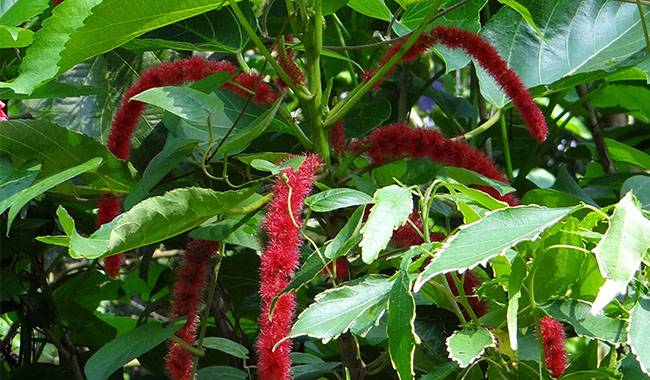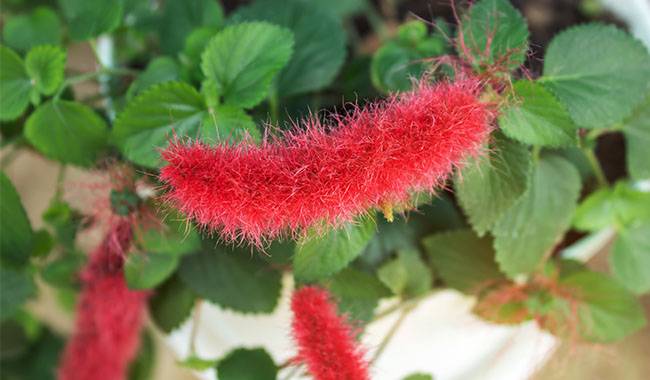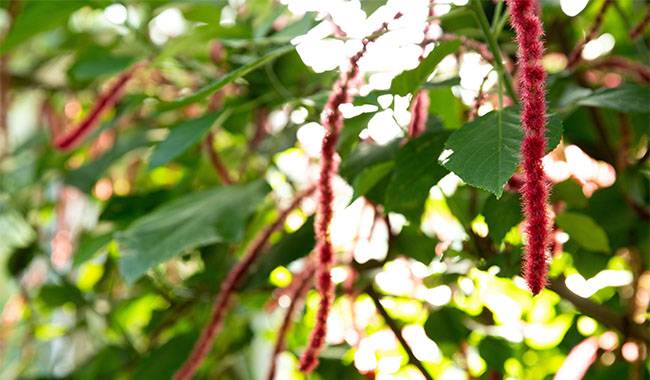
Choosing houseplants by texture is unusual, but it is a characteristic that makes Acalypha plants worth considering. This plant will easily add to interesting and unique interior decorations. And trumps the familiar and more common acalypha bristly. The fluffy effect of this conifer’s short inflorescence perfectly complements its green color, making the plant a bright star all year round. Acalypha oak leaves will shine in any company placement of Acalypha. It is the most capricious species of Acalypha, but also the most striking. Ordinary (regular) care cannot be done without it, as this species can only show its lush beauty under ideal conditions. You will learn how to grow Acalypha plants in ThumbGarden’s article.
ACALYPHA PLANT DESCRIPTION
While all attention is drawn to the ephemeral and rather capricious, but even suitable for beginners, acalypha bristly or Acalypha hispaniolae, other species of florists are undeservedly overlooked. A special kind of oak is formerly known as acalypha bristly or Acalypha hispaniolae, now officially renamed Acalypha chamaedrifolia. It stands out for its opulence, grace, and the cloudy, lace-like mat of its small leaves. It is a popular alternative to the classics and is a very cheerful plant that brings cheer to any room.
In contrast to the classic Acalypha, Alopecurus myosuroides is mainly cultivated in the ampelagic zone. As a result, its soft shoots flow down beautifully, bending and tangling in a lush, bushy, spreading mat and appearing lacy and curly. Compared to Lysimachia, this densely branched, more compact plant only grows to a height of 12 inches (30 cm). But don’t be in a hurry to plant this species only in hanging baskets. It also looks great in a vase, hanging slightly over the edge. And in the winter garden, it can even be used as ground cover.
The leaves of this species do not exceed 2 inches (5 cm) in length and will stand out against the usual background of large-leaved eucalyptus. So the appellation “small-leaved” is more appropriate for Acalypha oaks with leaves.
It is heart-shaped, elongated, with serrated edges, pubescent and velvety, soft leaves of alternating shapes, surprising with their light, warm and pleasant mid-green hues. Creeping Acalypha’s color shades, like the shape of the leaves, are reminiscent of lemon balm or catnip.
Dense, velvety spikelets dangle from slender pedicels but bend a bit as they open and grow interestingly upward, which gives them a pepper-like shape. The inflorescences do not exceed 4 inches (10 cm) in length and are usually limited to about 2 inches (5 cm). Their coloring is always typical – a bright, deep red cool shade that appears dazzling and gorgeous. The inflorescence looks heavy, and its drooping shape creates the illusion that the twigs cannot bear their weight.
For Acalypha plants, the length of flowering depends on the light. If the plant is comfortable, it will not stop flowering throughout the year, but even in the best locations, without additional light, it usually does not bloom for more than 8-9 months.
Like all acacias, Acalypha leaves are poisonous. When handling the plant or growing it in homes with small children and curious pets, care should be taken.
GROWING CONDITIONS FOR ACALYPHA INDOORS

Acalypha leaves are very heat-loving, even in winter when temperatures drop to 59-60 °F (15-16°C), which is considered a great stressor. Plants are most decorative when temperatures are stable at 62-70 °F (17-21 °C), at which temperatures the leaves grow more densely, colors are more vibrant, and blooms are surprisingly long. If temperatures exceed 73 °F (23°C), it is best to make ventilation more frequent. This plant is not particularly sensitive to drafts, but it is best not to expose the lush mats of Acalypha flowers to sudden changes in temperature when ventilating.
Like all its congeners, Acalypha is sensitive to direct sunlight. However, its lush, uniform flowers throughout the canopy are only characteristic of it in bright enough light. It is best not to shade it and choose a western or eastern bay window (and similar locations for diffused light.) Acalypha blooms year-round and can be made to bloom with the help of timely supplemental lighting or by moving it to a south-facing window.
CARING FOR ACALYPHA PLANTS AT HOME

Acalypha needs a stable, moist substrate. The ideal solution for plants is an automatic irrigation system or hydroponics, where stable, comfortable humidity will depend very much on controlling the watering frequency. However, a suitable irrigation regime can also be established quite successfully with conventional irrigation methods. Water Acalypha plants frequently, but not too much, allowing the soil to dry out only slightly.
Acalypha flowers are usually not sensitive to air humidity, but too much humidity and extreme dryness are not good. In the first case, the stalks will become sticky, and the plant may start to rot. In the second case, the green plant will not keep its lushness and freshness. In autumn and winter, especially when the central heating system is running, Acalypha can be protected from very dry air by gentle ventilation. However, in summer, it is best to combine frequent ventilation with sprinkling room temperature water.
Feed frequently, but not intensively. Fertilize throughout the plant’s growth and flowering period, reducing the frequency every 6 weeks from fall to spring and stopping if Acalypha plants are flowering. From March to October, the frequency of fertilization is every 2 weeks. For this species, it is best to use a compounded all-purpose fertilizer, reducing the standard dosage by a factor of 2.
Prune Acalypha plants as they age. If conifers lose their shape, spread out, elongate, and become bare, looking emaciated and strongly aged, cut off the shoots in spring (March) to a height of about 12 inches (30 cm) to form a circular basal pillow. The twigs will soon grow, and the Acalypha plant will regain its usual lush appearance within a few months.
For Acalypha plants, the traditional procedure should be supplemented with loosening of the soil. The loss of permeability is crucial for the plant. It reacts particularly badly to the formation of crusts, so it is best to gently loosen the substrate once a month to maintain the lightness of the soil.
TRANSPLANTING, CONTAINERS, AND SUBSTRATES
Acalypha should not be disturbed unnecessarily. It should not be replanted until its root system emerges in the drainage holes. The second half of March or early April is not ideal for this. Transplanting of plants is carried out by laying drainage trenches in high places.
A universal soil can be used for Acalypha plants, but it is advisable to add perlite or other loosening components to maintain constant permeability to simplify the work.
PESTS AND PROBLEMS IN CULTIVATION
Acalypha plants often suffer insect pests – aphids, whiteflies, spider mites. In the lush foliage of the plant, it is difficult to detect pests even on close inspection, so it is worth reacting immediately to their state of pressure and signs of damage – deformation when infested by aphids, discoloration when infested by whiteflies and spider mites. For this species, it is best to immediately remove the damaged parts and treat the shrubs with insecticides or herbal injections (tobacco, dandelion, onion).
PROPAGATION OF ACALYPHA PLANTS
This species reproduces itself more easily than its relatives. Although cultivation from seed is still the main way to obtain Acalypha, cuttings are most common in Acalypha plants. The dense branching of numerous shoots makes it possible to obtain dozens of cuttings without damaging the parent plant.
Cut the top of a strong shoot with two leaves and root it under any light, sandy substrate cover. Shoots root fastest in March, but with protection from heat – the optimum temperature for rooting is 70 °F (21 °C). They can be propagated successfully at any time of the year, with only a slight decrease in the “efficiency” percentage.







